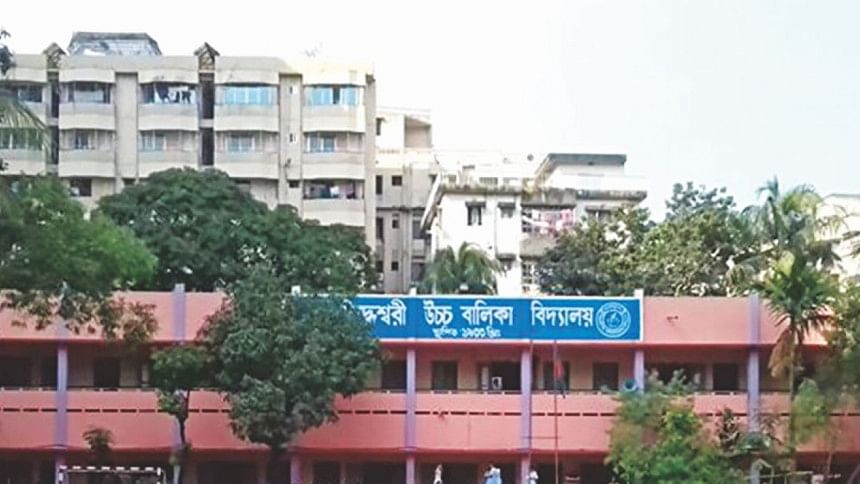The school bell still rings at my alma mater

The twentieth century had dawned to see the culmination of changes in all spheres of life. One of the most visible changes was in the education sector.
The British colonial period had seen the establishment of some schools, colleges, and university in the eastern part of Bengal. Some of these institutions were established by Christian Missions and philanthropists of that time.
Respected Muslim as well as Hindu personalities of the community also felt the need of establishing educational institutions in this part of the Bengal. Sri Bibhutibhushan Ahir was one of them, who, along with his wife, took the initiative to establish a school for both boys and girls at the Siddheswari area of Dhaka.
It was on 1 January of 1933 that Siddheswari School began, with only a few students. Both the husband and wife were actively involved with the school, spending their valuable time teaching students. Later, the couple donated the property to the school.
In the late 1950s, the School Committee bought a piece of land to have a separate school for the boys, and thus, the boys section moved to nearby locality as Siddheswari Boys' High School. The Girls' School remained at the same location, which is now known as Bailey Road.
The school has seen three different historic eras of political change --from the British Raj, to the partition of Pakistan, and the independent Bangladesh. Since its establishment, the school educational system has been changed, mostly for the betterment of the students.
I do not know the magnitude of change, but I can definitely claim that there is no change in the relationship between teachers and students. While I was studying there, I could remember a U-shaped two-storeyed building with an open space for playground for the students. The classrooms were bright and airy due to huge windows on both sides of the classrooms and long corridors on one side. The cool air from the ceiling fans used to bring relief from the scorching heat of summer. During monsoon, roads were flooded for a day or two, and we knew that a school closing was imminent. The school authority was very much concerned about the comfort and safety of the students. Guards were posted at the gate at all times, and no outsiders were allowed.
There were separate rooms for female and male teachers, a room for the Headmistress, and also a prayer room. The library was too small to mention. But the memory of the scary skeleton in the laboratory still gives me an eerie feeling.
There used to be a lake next to the school property, which was later gifted to the school by the Land Ministry of the Government. The lake was later filled up to make space for extra-curricular activities. Prize distribution day, Sports day and the Annual day were the highlight occasions. Many distinguished guests honoured the occasions with their spirited speeches.
Who could forget the first day in school in January with a new uniform, new books, and a new classroom? We waited eagerly for the ringing of the school bell for classes to begin.
Reminiscing about my school days in the late 70s, I fondly remember the Headmistress, Rahima Khatun, known as "Boro Apa," who was very disciplined and strict, and at the same time, very caring in nature. Her footsteps in the hallway always made us aware that she had her her watchful eyes on everyone.
Often, you could find the Headmistress engrossed in work at her desk. She used to teach English to the senior classes. Rahima Khatun served the institution for the longest period of time as Headmistress, from 1967-1996. Teaching styles differ from teacher to teacher. There were teachers whom I remember to this day, Abdur Rahim sir, Mujibur Rahman sir, Latifur Rahman sir, Habibur Rahman sir, Sitara apa, Mili apa...
Mujibur Rahman Sir's biology diagrams were so perfect that they almost looked like they were printed. Who would forget English teacher Shams-uddin sir, popularly known as "Tiger Sir" to us. We were back to our benches with pen and paper ready before "Tiger Sir" entered the class. There was always pin drop silence in his classroom.
I cannot recollect how many times I had pierced my thumb with needles in the sewing class. I hated stitch work and there was no escaping from it, but the teacher had so much patience to show me how to stitch immaculate patterns. Noor Jahan apa, who taught both English and Bangla, and also a relative of mine, took extra care of my sisters and I. I pay my heartiest thanks to all the respected teachers.
Many of our students are well established and have excelled in their respected fields. The school produced well-known professors, doctors, lawyers, engineers, writers, bankers, government and non-government officers. Some are actively involved in politics too as concerned citizens of the country. The teachers, with their limited resources, not only wanted the students to get the best education, but also to become good human beings. I have no doubt that they have succeeded in doing so. There are many avenues to venture in life after graduating from high school. Some blossom, and some do not, but the school provides equal education opportunity for all of them.
Every time I visualise the school, it brings back fond memories of my alma mater, and the happy times spent in school.
I end my note with a quote from Mustafa Kemal Ataturk, "A good teacher is like a candle — it consumes itself to light the way for others."
Photo courtesy: Aeman T Rasul

 For all latest news, follow The Daily Star's Google News channel.
For all latest news, follow The Daily Star's Google News channel. 



Comments